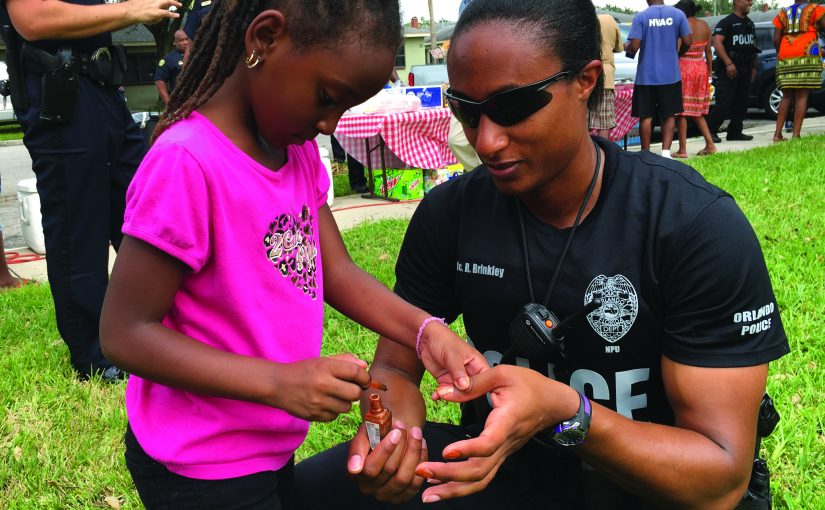The authors, Chief (Ret.) Ivonne Roman and Executive Director of the Center for Excellence in Policing and Public Safety Maureen McGough, joined forces to launch the 30×30 Initiative in March 2021 to improve the representation and experiences of women in policing. The initiative’s goals are simple:
- Understand how current policies and practices fail to meet women officers’ unique needs
- Understand how the status quo may be unintentionally biased against women and other underrepresented groups
- Work collaboratively with police departments to address these issues and ensure a truly diverse and inclusive workplace
The 30×30 team is confident that meeting these goals will lead to a significant increase in the hiring and retaining of women officers. Ultimately, the hope is to see women making up at least 30 percent of U.S. police recruit classes by the year 2030.1 In the last three years, 30×30 has partnered with almost 400 agencies to work toward these goals, from federal agencies like the FBI and U.S. Marshals Service and major metro departments like the New York City Police Department and the Los Angelos, California Police Department, to state, mid-sized, small, and university departments in the United States and Canada. In addition, the initiative has established formal collaboration with the Bureau of Justice Assistance and the National Institute of Justice. More than 1,000 sworn women officers have participated in focus groups and surveys, and 30×30 has collected hundreds of progress reports from agencies engaged in gender equity work. And, in many ways, the work is just getting started.
Advancing Women in Law Enforcement Is a Matter of Public Safety
Enhancing the diversity of police agencies to better reflect the communities they serve has long been recognized as a crucial step in fostering community trust. Recently, there has been increasing recognition of the particular importance of improving the representation and experiences of women in policing, especially with regard to improving public safety outcomes.
A growing body of scientific evidence demonstrates the unique contributions of women officers. Though further research is needed, preliminary findings indicate that women officers use less force and excessive force less often and use their discretion to make fewer arrests for minor misdemeanor offenses.2 They search drivers less often during traffic stops—but when they do conduct a search, they are more likely to find contraband.3 They are named proportionately less often in complaints and lawsuits and are perceived by the communities they serve as more trustworthy and compassionate.4 They fire their service weapons less often.5 They are associated with better outcomes for victims of crime—especially victims of sexual assault.6
This is not to say that every woman would make an exceptional officer, nor that every man would not. This simply indicates that, in many important aspects of improving both the profession and the public safety outcomes of communities served, women officers can play a critical role. If a training program promoted these kinds of outcomes, most agencies would be implementing that training. But instead, what this suggests is the field of policing must look critically at (1) why women historically have been so underrepresented, and (2) what agencies can do to improve both the representation and experiences of women in the profession.
The 30×30 Initiative is doing just that.
The 30×30 Pledge
The 30×30 Pledge, a crucial piece of the initiative, was developed with significant guidance from a steering committee that included women police executives, professional organizations, researchers, and policymakers. The pledge details a series of evidence-informed, no- and low-cost actions departments can do in the near term to improve both the representation of women in sworn positions and the experiences of women working in the department. When the pledge was first launched in 2021, it felt a bit like hosting a party—the founders weren’t sure anyone would show up. However, there has been incredible receptivity from the field, with participation of agencies of all sizes across the United States and several Canadian agencies, as well as a growing interest from agencies around the world.
The pledge takes a straightforward approach to data-driven insights at every stage of an officer’s career: recruitment, assessment and hiring, retention and promotion, and overall agency culture. The pledge also relies heavily on improved data collection, which is critical for agencies to understand whether and how they may be losing women officers at disproportionate rates. And, most importantly, it ensures that the advances of the department are grounded in the lived experience of women in the agency.
Once agencies take the 30×30 Pledge, the team works with them directly to provide resources like research summaries, policy guidance, promising practices, peer-to-peer learning, social media strategies, and monthly newsletters and webinars. Agencies report their progress to 30×30 in six-month increments.
Equity, Not Tokenism
The 30×30 Initiative and the 30×30 Pledge have gotten a nearly universal positive response, including many passionate advocates who have taken up the mantle of gender equity in their own agencies. The little opposition these efforts have received has all been rooted in a fundamental misunderstanding of the initiative’s objectives and how they will be achieved.
For instance, there have been allegations of tokenism and “reverse sexism,” and there have been people who think 30×30 is advocating that agencies hire or promote women who are unqualified just because they’re women. Neither the pledge nor the broader work of 30×30 advocates that agencies hire or promote more women just because they’re women. Nothing could be further from the truth— and, in fact, doing this work that way would undo decades of progress and negate the accomplishments of the exceptional women who have come before.
What 30×30 does advocate for, however, is that agencies seek to understand whether they’re treating women equitably and meeting their needs. The reality is that policing is a profession built by and for men. It is not surprising that the status quo does not contemplate the unique needs of women officers nor capture their unique value. The assertion is not that women should get preferential treatment, but that they deserve an equitable shot.

For example, one area where there seems to be the greatest misunderstanding is around physical fitness assessments. Data show that many departments lose disproportionate numbers of women applicants at the physical fitness stage of assessment. In most departments, these assessments have never been validated, meaning there’s no evidence as to whether they actually measure what’s required to do the job well. 30×30 does not advocate for agencies to eliminate the physical fitness exam or hold women to different or lower standards—but it does advocate for agencies to use hiring processes that accurately assess a candidate’s ability to do the job.
In most departments, gender disparities are wholly unintentional. In most of these areas, agency leadership (which in some departments has never included a woman) are simply unaware of how the status quo fails to meet women’s needs or is biased against them. Once police leaders are aware of these problems, many take an inspiring amount of intentional action to remedy them.
Advancing Women in Policing
With nearly 400 agencies participating in the 30×30 Pledge, there has been an incredible amount of progress and innovation. The following areas are emerging as critical—and imminently doable—for the advancement of women:
Public, sustained leadership support. Leadership commitment to creating and sustaining a diverse and inclusive workforce is the most important aspect of this work. When agency leaders publicly affirm their commitment to advancing the pledge’s objectives, it sends a strong internal and external message about the value of women in the department. Importantly, leaders must buttress their affirmed support with specific action and continued commitment. Words are not enough. And the message must be clear: this is not about tokenism , but instead is about ensuring women are equally valued and have an equitable shot at inclusion and success.
Women-centered approaches. It is imperative that all department efforts to advance gender equity contemplate the experiences and priorities of the women currently serving with the department. Surveys and focus groups are an excellent way to get a real-time understanding both of needs and suggestions for how best to meet them moving forward. 30×30 offers a survey template for agencies, as well as a tool kit and webinar for agencies interested in conducting their own focus groups.

Intentional recruitment strategies. Agencies are creating inclusive recruitment materials (like NYPD, Saanich PD, and Madison PD) that move away from traditional, hyper-masculine, inaccurate depictions of what the job of policing entails and who is best suited to do the work. They also are creating and implementing strategies to reach candidates in other fields that require similar skills like service orientation, empathy, interpersonal skills, and emotional intelligence. Many of these fields—like nursing, education, psychology, and social work—have an overrepresentation of women. These 30×30 webinars explore research and promising practices related to recruitment. In addition, RTI has developed a resource that offers excellent guidance on messaging for inclusive recruitment materials.
Streamlined application processes. Research shows that lengthy application processes and barriers to entry that have nothing to do with whether or not someone can do the job (e.g., filing fees) cause disproportionate attrition rates for under-represented groups.7 Some agencies are using 30×30 involvement as an opportunity to streamline their application process and collect better data throughout—so they can diagnose where they may be losing disproportionate numbers of candidates from underrepresented groups and determine whether that step in the process is necessary for adjudicating an applicant’s abilities. (This 30×30 webinar explores issues related to the application process.)
Clear, appropriate pregnancy policies. Many women have expressed that their department did not have a pregnancy policy, and some women officers reached out to 30×30 because they are the first pregnant officer their department has ever had. It is imperative that departments have clear pregnancy policies that include information about transitions to light duty and that require input from an officer’s medical provider (rather than leaving it up to supervisors to determine when light duty is appropriate). Some 30×30 agencies have implemented improvements to their pregnancy policies that reflect these important considerations.

Clear, appropriate parental leave policies. Many women officers have voiced that parental leave policies—if they exist—are convoluted and inconsistently applied. Agencies must have policies that clearly lay out what parental leave options are available. If possible, leave policies should include additional support for women returning to the workplace after giving birth and allow more than six weeks leave in recognition of the physiological and psychological challenges of postpartum recovery, especially if a woman is returning to patrol. Agencies should consider transition plans that include support for women to heal, regain physical strength, and re-qualify for firearms.
Improved spaces for pumping breast milk and clear lactation policies. One of the first action items in the 30×30 Pledge involves ensuring women returning to work after giving birth have a designated, appropriate space to pump breast milk that is private, has electricity, and includes options for refrigeration. Many agencies were able to implement this action item quickly or already had it in place, and others turned to more temporary modular solutions such as lactation pods. A video from the Vermont State Police describes how they built their own network of nursing spaces to support women officers. Importantly, departments also need to implement policies that allow nursing mothers sufficient breaks to pump breast milk and express they are not expected to multitask during pumping, as this could negatively impact milk production. For all policies, especially those related to supporting women during and after pregnancy, supervisors must be trained to ensure compliance and consistent application.
Part-Time Options/Job-Sharing. Women bear a significantly disproportionate responsibility for caregiving and managing family responsibilities, and part-time options for parents and caregivers returning to the workplace help alleviate that burden. In exploratory research with agencies in countries who are closing the gender equity gap, agency leaders named the adoption of job-sharing policies as the most important policy change they instituted to improve retention of women officers. Some agencies already have successfully implemented these policies and others are in the process of design and implementation. (This 30×30 issue brief offers guidance for developing and implementing these policies, and this webinar includes lessons learned from agencies who have implemented these policies.)
Childcare facilities. In every focus group 30×30 has hosted, women officers identify childcare as one of their biggest challenges. Many women reported a lack of affordable options or a lack of any option during overnight shifts. Many women report choosing not to seek promotions because they would not have childcare options if they lost their day shift. The San Diego, California, Police Department recently launched the first childcare facility of its kind for their officers.8 A new organization of individuals who spearheaded the establishment of the San Diego Center, the National Law Enforcement Foundation, is helping other jurisdictions build their own centers across the United States. (This 30×30 webinar explores the establishment of the San Diego childcare center.)
Women-specific equipment and uniforms. Women from across the United States and other regions have noted that uniforms and personal protective equipment often do not fit nor appropriately protect them. These problems can be addressed through specific procurement requirements. For example, some agencies are adding language in requests for proposals that ballistic resistant vest manufacturers must include women-specific models and ensure appropriate measurement and fit for women’s bodies. Others have established working groups of women officers to identify and select uniform providers who have options for uniforms for women that do not require additional tailoring.
Support throughout the application process. As previously noted, many standards and assessments departments use have never been validated, and some of these assessments are disproportionally excluding women. While revising standards and assessments is complicated, often requires external partners, and takes time, departments can take immediate steps to support applicants through the process as it currently exists. For example, some departments are using training programs to make sure potential applicants are aware of physical fitness requirements and are appropriately trained to meet them, such as the Indianapolis Metropolitan Police Department’s Pre-Academy Readiness Program or the Edmonton Police Department’s Run With Recruiters program.
Mentorship and Communities of Practice. Research has long demonstrated the critical importance of mentorship for professional development. Some departments have their own mentorship programs, communities of practice, and women-focused professional development like Mesa, Arizona, Police Department’s annual Women’s Leadership Symposium. In some jurisdictions women officers have formed their own organization (such as Los Angeles Women Police Officers and Associates). In Dallas, women officers recently formed the Dallas Police Women’s Association—a union focused on improving working conditions for women officers. And many women officers are participating in regional and national mentoring and networking organizations such as the National Association for Women in Law Enforcement (NAWLEE) and New York Women in Law Enforcement (NYWLE). (This 30×30 webinar explores promising practices for establishing communities of practice.)
What’s Next: Sustained, Widespread Progress
In 2023, 30×30 established a formal collaboration with both the Bureau of Justice Assistance (BJA) and the National Institute of Justice (NIJ) at the U.S. Department of Justice. These collaborations have led to very exciting new resources and support for agencies participating in 30×30.
Bureau of Justice Assistance: Technical Assistance Center. Under the leadership of Director Karhlton Moore, BJA invested $1 million through a competitive process for a technical assistance center to support 30×30 agencies. This center will oversee agency participation in the initiative, will develop a suite of evidence-informed resources and model policies and, most important, will administer a microgrant program that directly funds agency activities in furtherance of the 30×30 Pledge. The National Policing Institute will run this center, which will launch this spring.
National Institute of Justice: Evidence-Based Implementation Guide and Updated Pledge. The NIJ has funded a thorough analysis of 30×30 agency progress to identify what matters most; a robust literature review to identify what works and what matters to advance women across disciplines; and, most importantly, an updated implementation guide for recruiting and retaining women officers. The current version of this guide, developed by the National Center for Women in Policing, was funded in 1999. This critical update will include innovations from 30×30 agencies and will contemplate current and future trends for recruitment, retention, and culture change. This guide should be available later this year.
State-Level Change. While 30×30 is thrilled with the number of agencies it has engaged in this work, they represent only a small percentage of police agencies in the United States. Changes in leadership at the local level can delay or derail efforts to improve gender equity; therefore, with support from Arnold Ventures, 30×30 is beginning to engage state governments in the development of standards and statewide policies that advance 30×30 objectives. in addition, a legislative strategy to advance this work with U.S. state and federal legislators is in development. d
Notes:
1The theory of representative bureaucracy suggests that it is not until an underrepresented group reaches 30 percent representation that they can meaningfully impact the culture of their organization for the benefit of that group. See Changgeun Yun, “Politics of Active Representation: The Trade-off Between Organizational Role and Active Representation,” Review of Public Personnel Administration, 40, no. 1 (March 2020): 132–154.
2P. Colin Bolger, “Just Following Orders: A Meta-Analysis of the Correlates of American Police Officer Use of Force Decisions,” American Journal of Criminal Justice 40 (2015): 466–492; Bocar A. Ba et al., “The Role of Officer Race and Gender in Police-Civilian Interactions in Chicago,” Science 371, no. 6530 (February 2021): 696–702.
3Kelsey Shoub, Katelyn E. Stauffer, and Miyeon Song, “Do Female Officers Police Differently? Evidence from Traffic Stops,” American Journal of Political Science 65, no. 3 (July 2021): 755–769.
4Kimberly D. Hassell and Carol Archbold, “Widening the Scope on Complaints of Police Misconduct,” Policing: An International Journal of Police Strategies and Management 33, no. 3 (August 2010): 473–498; Kim Lonsway and Michelle Wood, Men, Women, and Police Excessive Force: A Tale of Two Genders, National Center for Women and Policing, 2002; Tiffany D. Barnes, Emily Beaulieu, and Gregory W. Saxton, “Restoring Trust in the Police: Why Female Officers Reduce Suspicions of Corruption,” Governance 31, no. 1 (January 2018): 143–161.
5Renee Stepler, “Female Police Officers’ On-The-Job Experiences Diverge from Those of Male Officers,” Pew Research Center, January 17, 2017.
6Amie M. Schuck, “Women in Policing and the Response to Rape: Representative Bureaucracy and Organizational Change,” Feminist Criminology 13, no. 3 (2018): 237–259.
7Ideas42, “Behavioral Science 101.”
8San Diego Police Officers Association, “SPOA Childcare Center.”
Please cite as
Ivonne Roman and Maureen Q. McGough, “What Works and What Matters to Advance Women in Policing: Lessons Learned from the Field,” Police Chief Online, March 6, 2024.



